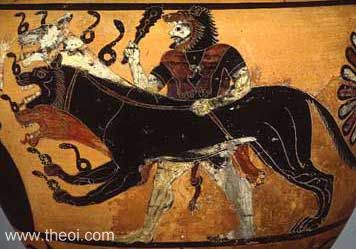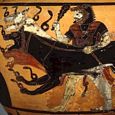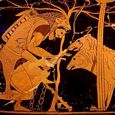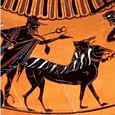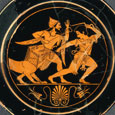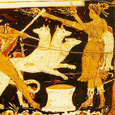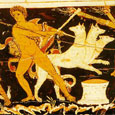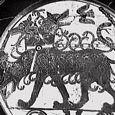
hi my names tara and i love mythical creaters learn about them here and play a fun dragon game
unicorns,griffens,dragons,phoenix,cerabus,peguses all of theses basts on this page

unicorns

Unicorns
A silver shadow flits through the night,
Just a glimpse of it will make you question your sight,
For it is a creature of mythical delight.
Lost from the World for centuries,
The Unicorn who once stood so proudly.
With its horn proudly piercing the air,
It was then a creature to fear ...
Alas as with so many creatures of old.
It has been forever lost to this world.
Yet the magic it created still remains,
I feel the magic of the beast run in my veins.
Run through the forest in my dreams.
Nothing is ever as it seems.
Cause there are different realities,
That only the tuned in can see,
A place where the enlightened can be free.
Where faeries, elves and spirits play,
And the Unicorn can freely graze.
Weave its magic way,
Appear from out of the gloom,
Be free once more to roam ... CJA
Fabulous beast of untamed wildness.
An embodiment of noble pride, purity of spirit and mysterious powers.
Strangers to mankind, unicorns dwelt far away from humanity.
Seeking out mountains, forests, places where magic might still be found.
The unicorn would miraculously appear to the purest of heart.
In whose presence it would become truly gentle.
Only then would it share its magic with these who believed in its glorious power.

dragons
Stories of dragons appear all throughout history and almost every culture has their own idea about dragons. Some reasons for this could be the finding of dinosaur fossils. Dragons could be used to describe the indescribable bones of unknown creatures. There are stories about dragons in every part of the world, with the exception of Antartica. Even though there are no people in Antartica, which in that way would seem to make it attractive to dragons, the climate proposes a problem for these creatures who like fire or live in water, but not ice water.
One type of dragon, or sea monster, was feared back in the time of Christopher Columbus. During this time when the world was thought to be flat, these dragons were said to be at the edge of earth, waiting to eat any one who dared to sail that far into the ocean. This story kept many people from exploring farther into the world. Maps were even made marking the place where these dragons lived. At the edge of the map the words "Here Be Dragons" was almost always printed.
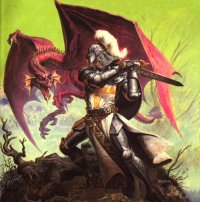
Dragons have also appeared in stories that go back to the time of the gods in mythology. The story of Perseus and the Dragon of Posdeidon tells of a vain queen who almost sacrificed her daughter to the dragon, had it not been for Perseus.
Dragons appear most in fairy tales and myths. In most cases the dragon is the keeper of some treasure, either gold and precious jewels or a maiden in despair. A knight in these stories must come to rescue the girl, or to retrieve the riches. To do this he must slay the dragon.
Almost all young children have heard stories of dragons. A story that arose from the Middle Ages is about a knight, later called St. George, who rescued a princess from a dragon and in return was able to baptize the Pagan people to Christianity. The story says that every year a maiden was sacrificed to this dragon. One year when the princess was going to be sacrificed, St. George decided to rescue her. Using his sword, Ascalon, he was able to stab the dragon and later slay him. This may be one of the most popular heroic stories involving the death of dragons, although there are many. The story of St. George and the Dragon has been told for centuries and the event was even painted by the great artist Raphael.
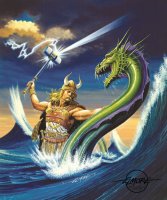
Like St. George and the Dragon, many other stories have been told about dragons and the heroes who kill them. One story like this comes from Norway. The king left his daughter in the castle while he went away on a long trip. He left her a tiny dragon to be her guardian. The princess was skeptical of the tiny creatures, fearing that it could not protect her. However, the dragon soon grew into a large monster. He soon became too good of a guardian for the princess when he grew large enough to wrap his body all around the castle and not let anyone in or out of it. When the king returned home, even he was not permitted inside the castle. The only thing to do was to kill this dragon, so the king offered his the marriage of his daughter to anyone who could kill this dragon. No man in Norway was capable, but a man in Sweden finally killed the beast. As his reward he married the princess and they returned to Sweden together.
Another story is about another young man who fought a dragon for the reward of bringing the king's daughter to his master for marriage. In this story Tristan is tricked by another man who wants the princess for his own wife. In the end Tristan cut off the dragon's tongue as proof of his accomplishment and the lies of the other man were discovered.
During the times of dragons in England, anyone who killed a dragon was awarded knighthood. In ancient Rome, dragons were thought to hold the mysteries of the earth. Romans looked to dragons as a source of knowledge and used them as symbols of strength for their military. They used two forms of dragons, one which was used for heroism, to protect them, and the other, a fearsome dragon, used as a threat.
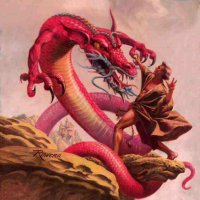
Other tales about dragons are more about their toes then the dragons themselves. How many toes a dragon has is quiet significant. Many different kinds of dragons are said to have 3 toes. The 4 toed dragons are said to be the earth dragons. But the 5 toed dragons are the most respected of all. Only a king or a high noble had the privilege of wearing a picture of the 5 toed dragon. In ancient times if a peasant was seen wearing the symbol of the 5 toed dragon, he would immediately be put to death.
Dragons seem to have come from exaggerated myths about huge snakes, lizards or other reptiles. One type of dragon is actually called the Wyrm, and has a very snake-like form, with a dragon head. Another smaller form of dragon is called a dragonlet. These dragons are also venomous and can be deadly. In the story The Dragonlet of St. Pilatus, only man with a bad temper and skills with a sword was able to defeat this monster that was only the height of the hero. In almost every culture and all throughout history there are stories of these magical creatures called dragons.
griffins
The griffin or gryphon is a mythical quadruped with the foreparts of an eagle and the rear, tail and hindquarters of a lion. Its eagle-like head had pointed, upstanding ears like those of an ass. Feathers grew upon its head, neck and chest and the rest of the griffin’s body was covered in leonine fur, subtly colored in shades of tawny brown. Aelian said the wings of griffins were white and their necks were variegated in colour with blue feathers. The griffin claws were especially valuable as they were reputed to change color in the presence of poison, which is why they made useful drinking vessels. At times, it is portrayed with a long snake-like tail. In some traditions, only the female has wings. Its nests are made of gold and its eggs resemble agates. It is supposed to be of gigantic proportions, the morphology being left to our own deduction after we have been informed that one claw is the size of a cow's horn.
There are a number of different types of griffins;
OriginThe Griffin was known in Egypt before 3300 BC and is possibly more ancient still. Pliny believed griffins came from Northern Russia; Aeschylus thought they originated in Ethiopia; and Bulfinch wrote that their native country was India. Herodotus said that legends of griffins came from the Issedonians who lived beyond the Oural Mountains. Biedermann wrote later that it has typological antecedents in ancient Asia, especially in the Assyrian k'rub, which is also the source of the Hebrew cherub.
RoleBecause of the griffin's strength and powers of sight, it was believed to guard hidden treasures and in particular the vast gold mines of India and Scythia. The Arimaspians, a bold, one-eyed race of humans, constantly tried to steal their treasure and eventually drove the griffins away the mountains. Because of its association with the Holy Grail, one of the treasures most commonly guarded by griffins was emeralds. Other popular treasures guarded by griffins were the Tree of Life, knowledge, and the roads to salvation. Greeks and Romans used griffin images to guard tombs. The griffin also became the adversary of serpents and basilisks, both of which were seen as embodiments of satanic demons.
PowersIn its body, the griffin is blessed with the speed, flight, and penetrating vision of the eagle and the strength, courage, and majesty of the lion. |
phoenix
The legend of the Phoenix has been around for centuries. There are a few variations, but the basic idea is this: The Phoenix is a supernatural creature, living for 1000 years. Once that time is over, it builds its own funeral pyre, and throws itself into the flames. As it dies, it is reborn anew, and rises from the ashes to live another 1000 years. Alternatively, it lays an egg in the burning coals of the fire which hatches into a new Phoenix, and the life cycle repeats. There are a few theories as to what might have given rise to such a legend. Perhaps a brightly colored bird was captured in Asia, and sold in a foreign land with wild stories about the bird's legendary powers, in hopes of jacking up the price. Perhaps someone saw a common peacock backlit by the setting sun, and believed the bird to be on fire. There are a myriad of possibilities, none of which can be confirmed. One theory about the origins of the Phoenix legend is rather bizarre, but may be closer to the truth than some others: The original 'Phoenix' may have been a crow or raven dancing in a dying fire. It sounds strange, but truth is often stranger than fiction. Ravens and crows have been known to practice a peculiar form of behavior called 'Anting'. The bird will disturb an ant's nest, or sit over something sweet (like spilled honey or an almost empty soda-pop can), spread out its wings, and allow ants to run up and down its body. It is thought that the ants give the bird a sort of 'back massage' this way, or that they feast on feather mites which live on the bird and cause irritation. For whatever reason, they seem to enjoy the sensation and have been known to do it repeatedly. In a similar way, some of these birds will sit over a hot surface, such as the dying embers of a fire, and spread out their wings. Perhaps they do it for the same reason we sit in a sauna - they just enjoy the heat - or perhaps they use the intense heat to encourage feather mites to find a different home. Since they won't talk, it's hard to tell. However, if a bird such as a large raven sits on the embers of a fire, and for some reason chooses to flap its wings (maybe as a way to cool off, or maybe because it's ready to take to the air) then it could stir the fire to life again. The sudden resurgence of flames around it would almost certainly cause the bird to take off. And voila - you have a bird rising from the midst of flames and ashes.
cerabus the three headed dog
KERBEROS (or Cerberus) was the gigantic hound which guarded the gates of Haides. He was posted to prevent ghosts of the dead from leaving the underworld. Kerberos was described as a three-headed dog with a serpent's tail, a mane of snakes, and a lion's claws. Some say he had fifty heads, though this number might have included the heads of his serpentine mane. Herakles was sent to fetch Kerberos forth from the underworld as one of his twelve labours, a task which he accomplished through the grace of Persephone.
Homer, Iliad 8. 366 ff (trans. Lattimore) (Greek epic C8th B.C.) : Homer, Odyssey 11. 623 ff (trans. Shewring) (Greek epic C8th B.C.) : Hesiod, Theogony 310 ff (trans. Evelyn-White) (Greek epic C8th or C7th B.C.) : Hesiod, Theogony 769 ff : Bacchylides, Fragment 5 (trans. Campbell, Vol. Greek Lyric IV) (Greek lyric C5th B.C.) : Aristophanes, Peace 315 ff (trans. O'Neill) (Greek comedy C5th to 4th B.C.) : Aristophanes, Frogs 468 ff : Plato, Republic 588c (trans. Shorey) (Greek philosopher C4th B.C.) : Pseudo-Apollodorus, Bibliotheca 2, 125 (trans. Aldrich) (Greek mythographer C2nd A.D.) : Pseudo-Apollodorus, Bibliotheca 2. 122 : Callimachus, Fragment 515 (trans. Trypanis) (Greek poet C3rd B.C.) : Euphorion, Fragments (trans. Page, Vol. Select Papyri III, No. 121 (1)) (Greek epic C3rd B.C.) :
Quintus Smyrnaeus, Fall of Troy 6. 260 ff (trans. Way) (Greek epic C4th A.D.) : Strabo, Geography 8. 5. 1 (trans. Jones) (Greek geographer C1st B.C. to C1st A.D.) : Pausanias, Description of Greece 2. 35. 10 (trans. Jones) (Greek travelogue C2nd A.D.) : Pausanias, Description of Greece 3. 25. 5 - 7 : Pausanias, Description of Greece 2. 31. 2 : Pausanias, Description of Greece 3. 18. 10 - 16 : Pausanias, Description of Greece5. 26. 7 : Pausanias, Description of Greece 9. 34. 5 : Diodorus Siculus, Library of History 4. 25. 1 (trans. Oldfather) (Greek historian C1st B.C.) : Plutarch, Life of Nisias 1. 3 (trans. Perrin) (Greek historian C1st to C2nd A.D.) : Pseudo-Hyginus, Preface (trans. Grant) (Roman mythographer C2nd A.D.) : Pseudo-Hyginus, Fabulae 30 : Pseudo-Hyginus, Fabulae 32 : Pseudo-Hyginus, Fabulae 151 : Pseudo-Hyginus, Fabulae 251 :
Ovid, Metamorphoses 4. 450 ff (trans. Melville) (Roman epic C1st B.C. to C1st A.D.) : Ovid, Metamorphoses 4.500 ff : Ovid, Metamorphoses 7. 412 : Ovid, Metamorphoses 9. 184 : Ovid, Metamorphoses 10. 21 ff : Ovid, Metamorphoses 10. 65 ff : Ovid, Heroides 9. 37 ff (trans. Showerman) (Roman poetry C1st B.C. to C1st A.D.) : Ovid, Heroides 9. 87 ff : Virgil, Aeneid 6. 417 ff (trans. Day-Lewis) (Roman epic C1st B.C.) : Virgil, Georgics 4. 471 ff (trans. Fairclough) (Roman bucolic C1st B.C.) : Propertius, Elegies 3. 5 (trans. Goold) (Roman elegy C1st B.C.) : Propertius, Elegies 3. 18 : Propertius, Elegies 4. 5 : Propertius, Elegies 4. 7 : Propertius, Elegies 4. 9 : Propertius, Elegies 4. 11 : Cicero, De Natura Deorum 3. 17 (trans. Rackham) (Roman rhetorician C1st B.C.) : Seneca, Hercules Furens 46 ff (trans. Miller) (Roman tragedy C1st A.D.) : Seneca, Hercules Furens 598 & 782 ff : Seneca, Hercules Furens 984 ff : Seneca, Hercules Furens 1107 ff : Seneca, Oedipus 160 ff : Seneca, Oedipus 559 ff : Seneca, Phaedra 222 ff : Seneca, Phaedra 843 ff : Seneca, Troades 402 ff : Valerius Flaccus, Argonautica 3. 224 (trans. Mozley) (Roman epic C1st A.D.) : Valerius Flaccus, Argonautica 6. 110 ff : Statius, Thebaid 2. 27 (trans. Mozley) (Roman epic C1st A.D.) : Statius, Thebaid 2. 52 ff : Statius, Thebaid 4. 410 ff : Statius, Thebaid 8. 53 ff : Statius, Silvae 2. 1. 183 ff (trans. Mozley) (Roman poetry C1st A.D.) : Statius, Silvae 2. 1. 228 ff : Statius, Silvae 3. 3. 21 ff : Statius, Silvae 5. 3. 260 ff : Apuleius, The Golden Ass 1. 15 ff (trans. Walsh) (Roman novel C2nd A.D.) : Apuleius, The Golden Ass 6. 19 ff : |
peguses the winged horse

If you look up in the sky on a crisp October night, you will see a large square of stars overhead. This is part of the constellation Pegasus, The Winged Horse.
According to Greek and Roman mythology, Pegasus sprang forth from the sea when drops of blood from the severed head of the horrible Medusa mixed with seafoam. He was befriended by a young man named Bellerophon and together the two performed many heroic deeds. But as so often happens with mortals, Bellerophon let his reputation get the better of him, and decided to ride Pegasus all the way to Mount Olympus, to join the gods. This would not do, so Zeus, king of the gods, sent a horsefly to sting Pegasus, who bucked and threw Bellerophon to earth. Pegasus was then allowed to join the gods in the sky, where we see him today. Bellerophon, on the other hand, was doomed to wandering the earth, lame and blinded, as punishment for his impudence.
The constellation of Pegasus today represents the head and forequarters of the famous horse. It is a large constellation, the seventh largest in the sky, in terms of area. The distinctive Great Square of Pegasus is marked by the stars Alpha Pegasi (or Markab), Beta Pegasi (or Scheat), Gamma Pegasi (or Algenib), and Alpha Andromedae (Alpheratz) and so isn’t officially completely within the constellation of Pegasus. The horse is upside-down in the sky for northern hemisphere observers, with his head facing south, and it doesn’t take much imagination to see him prancing through the night sky.
Pegasus is home to many wonderful deep-sky objects, including the magnificent globular cluster M15 (M for Messier, a French astronomer of the 18th century who began cataloguing non-stellar objects in 1758). It is a large ball of tightly packed stars that brightens noticeably toward the center. M15 emits a significant amount of x-rays, leading astronomers to suspect that there may be a black hole at the center of the cluster. M15 is located west and a little north of Epsilon Pegasi, or Enif, which marks the hoof of the horse’s front leg.
There are several galaxies located in Pegasus, but for the most part, they require a telescope to observe them, as they are too faint to be picked up with most binoculars. One of these, NGC 7331, which is located just north of Eta Pegasi, the star that marks the first bend in the rear leg of the horse, is a spiral galaxy very similar in size and form to our own Milky Way. There are several smaller, fainter galaxies to the east of NGC 7331 that may be associated with it in some way; they may be traveling through space together. About half a degree to the southwest of NGC 7331 is a very curious grouping of galaxies known as Stephan’s Quintet (NGC 7317, NGC 7318 A/B, NGC 7319, NGC 7320). These five galaxies are all bound together gravitationally and four of them appear to be interacting with each other. Four of these are fairly easy to pick out with a telescope of at least 10" in aperture on a dark night, with NGC 7318A and B appearing as one faint wispy ball of fuzz.
There are several fine double stars in Pegasus that are well worth a look. Struve 2799, located just 1 degree south/southwest of M15, is a triple star system. Kappa Pegasi is a very close double star, with a faint, distant companion, consisting of a yellow-white and an orange star; but since they are so close together, we see them, even though large telescopes, as one star. Kappa was discovered to be a binary star by S. W. Burnham in 1880, using the 36-inch refractor on Mt. Hamilton. It took all the great telescope’s power and very steady seeing before Burnham was able to split the two. Most of us amateurs do not have 36-inch refractors at our disposal, so we must content ourselves with the knowledge that the star is a double, but we aren’t likely to see each of its components. However, there are several other double stars in Pegasus that are not such demanding targets.
The Great Square of Pegasus is a most useful grouping of stars, or asterism, to locate and remember, because it serves as a "jumping-off" point for easy location of surrounding constellations, such as Andromeda, Aquarius, Pisces, and Cassiopeia. So look up often during those autumn nights and seek out the big square in the sky. From there we will travel to other wonders in the starry nights.
play a fun dragon game











